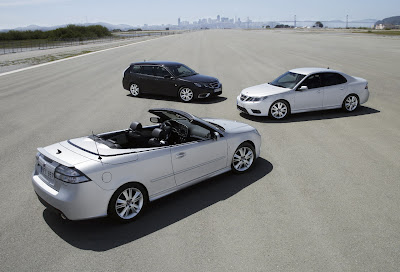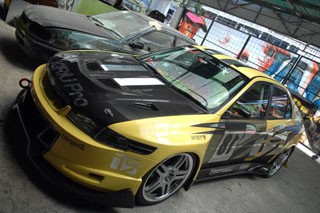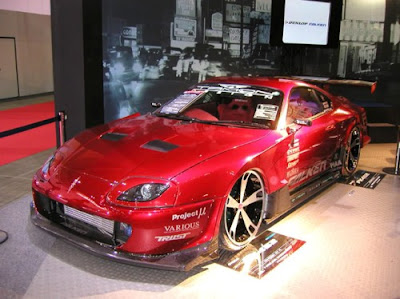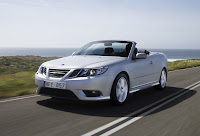 If you’ve been following our posts on the redesigned Saab we believe that you’ll agree with us that the 2008 9-3 must be one of the most leaked stories of the year. Having that in mind, we’ll spare you the obvious details (for Saab-nuts we’ve added the press release after the jump) and pinpoint the most interesting facts starting with the revised engine range.
If you’ve been following our posts on the redesigned Saab we believe that you’ll agree with us that the 2008 9-3 must be one of the most leaked stories of the year. Having that in mind, we’ll spare you the obvious details (for Saab-nuts we’ve added the press release after the jump) and pinpoint the most interesting facts starting with the revised engine range. As we had been tipped off earlier this year, the facelifted 9-3 features a brand-new AWD version fitted with the current 2.8-liter, 24-valve V6 Turbo engine uprated to 280hp and 400Nm maximum torque. It gives the Sport Sedan projected zero to 100 km/h (62mph) acceleration in 6.3 sec. Note that the AWD Aero version will not be available in the 9-3 Convertible.
Diesel fans will get a kick out of the new TTiD versions equipped with a (Fiat Group derived) twin-stage turbo 1.9L diesel pumping out 180hp and 400Nm of maximum torque. The revised Saab 9-3 range also features the introduction of a more powerful BioPower engine, in addition to the current option. Running on E85 fuel (85% bioethanol/15% gasoline), the new 9-3 BioPower 2.0t engine delivers 14% more maximum power (200hp vs 175 hp) and 13% more torque (300 vs 265 Nm). In the Sport Sedan, this gives projected zero to 100 km/h (62mph) acceleration in 7.9 sec compared to 8.5 sec on gasoline. -Click "Read More.." below for the press release along with 37 high-res images
Technorati: Saab, Saab+9-3, Carscoop, blogs, automotive, vehicles



New
- Modern Scandinavian design inspired by Aero X concept
- Saab XWD opens up new dimension in driving appeal
- Class-leading combination of power and fuel economy from new two-stage turbo diesel
The new Saab 9-3 range features bold, more assertive looks, reflecting a series of powertrain improvements that include the introduction of all-wheel-drive and more powerful diesel, gasoline and BioPower (E85) engines.
The distinctive frontal styling, inspired by Saab’s award-winning Aero X concept car, is designed to reinforce the range’s sporty appeal. It heralds the introduction of a ‘tri-fuel’ engine line-up that now includes, an innovative 180 hp (132 kW), twin-stage 1.9 turbo diesel, an uprated 280 hp (206 kW), 2.8V6 turbo gasoline engine and an additional 175 hp 2.0t Saab BioPower option, delivering 200 hp (147 kW) on E85 fuel
The advanced all-wheel-drive system (Saab XWD - ‘cross wheel drive’) is exclusive to 9-3 Aero Sport Sedan and SportCombi models. It features innovative developments in wheel slip management and the use of an electronically-controlled rear limited-slip differential.
The new 1.9-liter two-stage turbo diesel offers class-leading efficiency and is the first diesel engine in the premium segment to use an integrated two-stage tubocharging system.
Progressive Design
- Dynamic, cohesive looks with new front, rear and side aspects
- Frontal styling inspired by Aero X concept
- ‘Clamshell’ hood, clean body surfaces, smoked white rear light lenses
The new 9-3 range is visually distinguished by all-new bodywork forward of the A-pillar, with new bumper moldings and light assemblies front and rear, as well as new doors and handles for the SportSedan and SportCombi. Flared side sill extensions become standard across the range. All these elements combine to give the car a clearer Saab identity and a bolder, more assertive stance. For the Sport Sedan, for example, 70% of the external body panels and parts are all-new.
The styling strategy brings together contemporary and classic Saab design themes in a progressive, modern expression of the brand’s distinctive character.
The deeper, more prominent evolution of the Saab grille adopts a theme first seen on the Aero X concept car. This is complemented by all-new headlamp lenses and light units that now incorporate a thin ‘eyebrow’ lighting zone designed as a brand specific ‘signature’ feature. These wraparound units culminate in an upswept rear edge, introducing a Saab design theme from the 9-5 range and classic 900 model. The grille’s central wing motif, referencing Saab’s aircraft heritage, is, of course, retained.
The new look sees the adoption of another Saab signature feature: a ‘clamshell’ hood, closing across the top of the front wings. The hood pressing incorporates a sweeping, U-shaped styling line, as first seen on the Aero X, which echoes the curvature of the windshield.
The swept-back frontal lines are complemented by a front bumper and splitter assembly with a deep, trapezoidal air intake, even more pronounced on Aero versions. This is flanked by deep black vents which are framed, like the grille, in a matte chrome finish. As with the Aero X concept, these represent a metaphor for the intakes of a jet engine.
At the rear, the Sport Sedan and Convertible now feature smoked white light clusters. The new bumper moldings are much deeper with curved, uninterrupted surfaces. The trunk lids of the Sport Sedan and Convertible are also altered to accommodate a new matte chrome life handle trim with an integrated badge, similar that on the SportCombi.
The removal of all external rubbing strips from bumpers and doors (color-keyed on the Convertible) contributes to a cleaner and more cohesive overall appearance. New door panels now adopt a simple, uncluttered form with redesigned and color-keyed handles. The sill extensions are visually integrated front and rear with the scalloped corners of the new bumper moldings.
Other external enhancements include the introduction of flat wiper blades, for reduced wind noise, and new alloy wheels, with an 18-inch design now offered as an option on all variants apart from 1.8i models. Two new colors are added to the range, including a Snow Silver metallic paint finish similar to that seen on the Aero X.
Sporty Driver Focus
- Intelligent Saab XWD offers greater driver involvement
- Active system for class-leading performance, up to 100% rear torque transfer
- Cutting-edge technology: pre-emptive engagement and active rear LSD
- New rear sub-frame and suspension geometry
The active, all-wheel-drive system (Saab XWD) is designed to optimize handling and stability in all driving conditions. It is offered on Aero versions of the 9-3 Sport Sedan and SportCombi, in combination with an uprated 280 hp (206 kW), 2.8V6 turbo engine which delivers almost 15% more maximum torque (400 Nm) to exploit the greater traction available. It comes with a choice of six-speed manual or automatic transmission.
This state-of-the-art system includes two innovative features: pre-emptive engagement of the rear wheels to optimize traction at take-off; and an active rear limited-slip differential (eLSD), allowing variable torque transfer between the rear wheels.
Saab XWD is a fully automatic, on-demand system capable of sending up to 100% of engine torque to the front or rear wheels whenever necessary. While offering new Saab 9-3 Aero owners sure-footed handling in low-grip conditions, its sophisticated operation also adds a further sporty dimension to the driving experience in all road conditions. Fine balancing of the drive torque between the front and rear axles raises the threshold at which ESP throttle and braking interventions are triggered, providing more scope for closer driver involvement.
The system is governed by its own electronic control unit, which functions in harness with the engine, transmission and ABS/ESP control modules. The hardware consists of a Power Take-off Unit (PTU) in the front final-drive that transmits engine torque through a prop-shaft to the Rear Drive Module (RDM). This incorporates a Torque Transfer Device (TTD) and an optional electronically-controlled Limited Slip Differential (eLSD). Both are wet, multi-plate clutch units from Haldex.
At take-off from rest, the TTD is initially activated when the clutch plates are forced together under hydraulic pressure, thereby engaging the RDM. This pre-emptive function is a valuable improvement in current technology, which requires the detection of wheel slip before the TTD is activated. For the driver, the enhanced functionality gives maximum traction immediately for smooth, strong acceleration from rest without the possibility of any initial hesitation.
On the open road, drive torque is seamlessly and continuously varied between the axles by the control of a valve in the TTD, which increases or reduces the pressure on the wet clutch plates. When cornering, Saab XWD rewards the driver by providing enhanced, more finely balanced chassis dynamics. Data from the vehicle’s ABS/ESP sensors - measuring wheel speed, yaw rate and steering angle – is utilized, and careful programming of Saab XWD enables the application of rear drive to balance oversteer and understeer characteristics, improving stability and roadholding.
In highway cruising conditions, when traction or optimum grip is not an issue, only 5% to 10% of engine torque is typically transmitted to the rear wheels. This helps provide the driver with a measure of greater stability, while helping to save fuel.
The ultimate ‘icing on the cake’ with Saab XWD is the eLSD option. This is the first application of an electronically-controlled, rear limited slip differential in this segment of the market. The eLSD is installed alongside the RDM and operates via pressurized clutch plates on a principle similar to the larger TTD. In icy or wet split-friction conditions, for example, it uses inputs from the rear wheel speed sensors and can transfer up to 40% of torque between the drive shafts, to whichever wheel has more grip.
The eLSD also gives the driver enhanced control when cornering hard or completing a high speed maneuver, such as a lane change, by momentarily applying more or less torque to either of the wheels to help the rear of the car more closely follow the direction of the front wheels. This yaw damping effect can keep the car better balanced and more tightly controlled, without requiring ‘outside’ intervention from electronic stability aides.
Installation of Saab XWD includes the fitment of a new rear sub-frame to carry the RDM, revised rear suspension geometry and new wheel hubs for the drive shafts. The three piece prop-shaft runs through two bearings with constant velocity joints for smooth running with minimal ‘wind-up’. Wheelbase and rear track dimensions are unaltered. Saab XWD will be available from the beginning of next year.
Other driving enhancements include:
Sport Mode standard for automatic transmissions. This can be selected via an instrument panel button and aligns gear selection more closely with the intentions of the driver. If the driver momentarily lifts of the throttle, the current gear will be held for more effective engine braking and a quicker acceleration when required. During braking, downshifts are also faster and more closely matched to the rate of vehicle deceleration.
Optional cornering bi-xenon headlights provide improved vision. The steering-linked bulbs can swivel up to 15 degrees when negotiating a bend or corner above 15 kph. In highway driving above 110 kph, the low beam is also automatically raised slightly for improved illumination.
Responsible Performance
- Class-leading two-stage diesel turbo engine
- Extension of Saab BioPower
- More power for 2.8V6 turbo in combination with Saab XWD
New 1.9 TTiD engine
The 9-3 range features a powerful new four cylinder diesel engine with a unique two-stage turbocharging system, a world ‘first’ in the premium car segment, giving class-leading levels of efficiency. The 1.9-liter, 16-valve engine, badged TTiD, produces 180 hp (132 kW) and 400 Nm of maximum torque, specific power outputs that are unmatched among competitor products on the market. With combined fuel consumption of 5.9 l/100k projected for the Sport Sedan, this engine also offers class-leading economy, together with in-gear performance on a par with the 2.8V6 turbo gasoline engine.
The two-stage turbocharger housing is integrated with the exhaust manifold and contains two turbochargers of different sizes. The pair of turbine/compressor wheels are sequentially mounted and each is able to by-pass the input and output feeds of the other, while also being able to operate in tandem.
This arrangement provides a driver with ‘the best of both worlds’: good, instant torque at low engine speeds - via the low-inertia small turbo when the exhaust pressure is light - and strong ‘top end’ power at higher revolutions, when the bigger turbo is engaged.
Saab’s two-stage turbocharging uses a system of by-pass valves that directs the exhaust gas stream between the two turbine wheels and also separates the air intake charge from the compressors. From tick-over to 1,500 rpm the exhaust feeds only the small turbo. Between 1,500 and 3,000 rpm the flow is split between both turbines, giving stronger boost and ensuring a smooth transition phase to full power operation, above 3,000 rpm, when only the larger turbo is engaged.
The compact design provides more efficient packaging than systems using two separate turbochargers linked together externally in series. It ensures that the complex control and regulation of gas flows on both the exhaust turbine and intake compressor sides is achieved with a minimal number of seals and connections.
The TTiD engine is a substantial development of the current 16-valve 1.9TiD unit, using common rail, direct and multiple fuel injection. It operates with a maximum boost pressure of 1.8 bar (1.4 bar for the current engine) together with a slightly lower compression ratio of 16.5: 1 (17.5:1). The cast-iron block, alloy cylinder head and all internal components are strengthened as necessary to withstand the higher thermal pressures.
The exhaust gas re-circulation (EGR) system is characterized by extremely efficient cooling and now includes an electronically controlled by-pass for improved emissions. This feature, together with the fitment of a maintenance-free exhaust particulate filter, is expected to ensure compliance with more stringent future Euro 5 emissions standards.
Other technical enhancements include the adoption of a larger air-to-air intercooler, for better cooling of the intake charge; the introduction of more efficient pre-heating elements inside the cylinder head, for faster starting in cold conditions; and the use of a weight saving plastic intake manifold.
The Saab TTiD engine meets a growing demand from drivers unwilling to sacrifice performance in the interests of fuel economy. With power characteristics typical of a much larger engine, it is an example of Saab’s commitment to ‘right-sizing’, the achievement of ‘big’ engine performance without the usual drawbacks, such as extra weight, bulk and higher fuel consumption.
In recognition of its outstanding performance, the Saab TTiD engine is available in Aero specification, as well as Linear and Vector. It is offered in all three bodystyles, in addition to the current 120 (88 kW) and 150 hp (110 kW) 1.9 TiD engines, with a choice of six-speed manual or automatic transmissions.
New 2.0t BioPower
Saab leads
Running on E85 fuel (85% bioethanol/15% gasoline), the new 9-3 BioPower 2.0t engine delivers 14% more maximum power (200 hp/147kW v 175 hp/129 kW) and 13% more torque (300 v 265 Nm). In the Sport Sedan, this gives projected zero to 100 kph acceleration in 7.9 sec and 80 to 120 kph in fifth gear in 10.0 sec, compared to 8.5 sec and 11.1 sec, respectively, on gasoline.
E85 has a higher octane rating (104 RON) than gasoline (95 RON), and turbocharging with Saab BioPower allows the use of a higher boost pressure and more advanced ignition timing than is possible with gasoline. This gives more engine power, without risk of harmful 'knocking' or pre-detonation.
Saab’s 32-bit Trionic 8 engine management system controls the throttle setting, ignition timing, fuel injection, air mass and turbo boost pressure. It is a powerful platform that has facilitated software re-programming to accommodate the different ignition timing and fuel/air mixture requirements of E85. The only hardware modifications necessary to the all-aluminum Saab 9-3 engine are the fitment of more durable valves and valve seats. Bioethanol-compatible materials are also used in the fuel system, including the tank, pump, lines and connectors.
Trionic monitors fuel quality after every visit to the filling station and automatically makes any adjustments necessary for running on E85 and/or gasoline in any combination. That means Saab BioPower drivers can also use gasoline, should E85 not be available.
Uprated 2.8V6 Turbo
For the new 9-3 Aero XWD models, the current 2.8-liter, 24-valve V6 Turbo engine is uprated to 280 hp (206 kW) and 400 Nm maximum torque. This has been achieved to by increasing available boost pressure from 0.5 to 0.8 bar. It gives the Sport Sedan projected zero to 100 kph acceleration in 6.3 seconds and 80 to 120 kph (fifth gear) in 7.9 seconds.
The advanced specification includes: a lightweight, all-aluminum construction; variable inlet valve timing; a twin-scroll turbocharger and hydroformed exhaust manifolds with stainless steel liners and air injection for improved cold starting. In two-wheel drive applications, this engine now offers a 5 hp (4 kW) increase in maximum power, to 255 hp (188 kW).
Other enhancements include:
Tire Pressure Monitoring (TPM). This warns the driver if pressure in any of the tires drops below the recommended level. Sensors in the valves initiate a radio signal and a warning message is illuminated in the main instrument display, indicating which wheel(s) has lost pressure. TPM is offered as option on Aero models and comes as standard if 18-inch wheels are specified.
Bose Centerpoint Surround Sound audio. Available as an option on all Sport Sedan and SportCombi variants, this offers exceptional reproduction quality through five channels from CD, MP3 or XM digital radio sources. Surround sound quality is automatically provided even if a CD is not encoded for it. With 11 (sedan) or 10 (combi) speakers, performance is optimized for the acoustic requirements of each passenger cabin.



















































